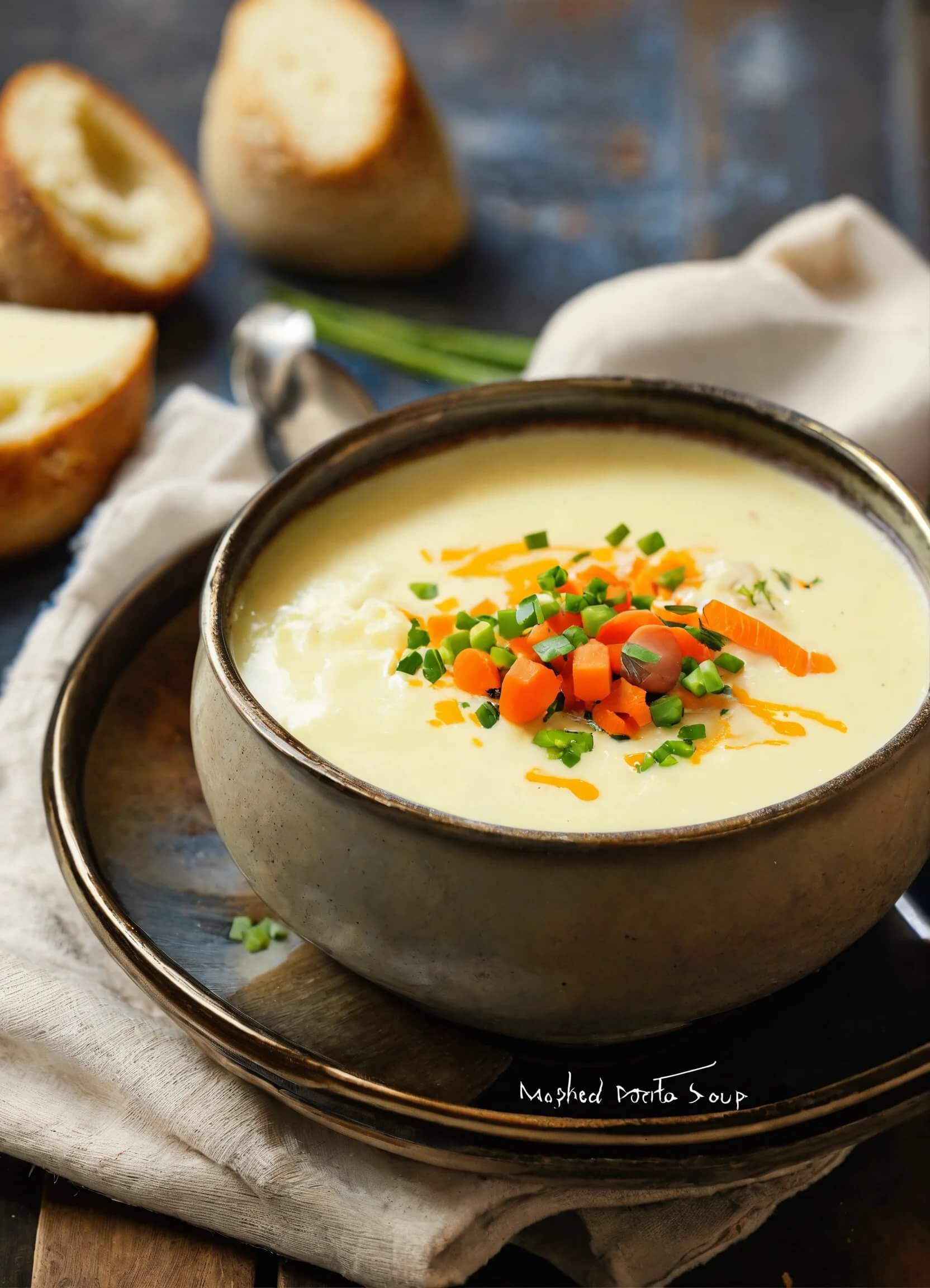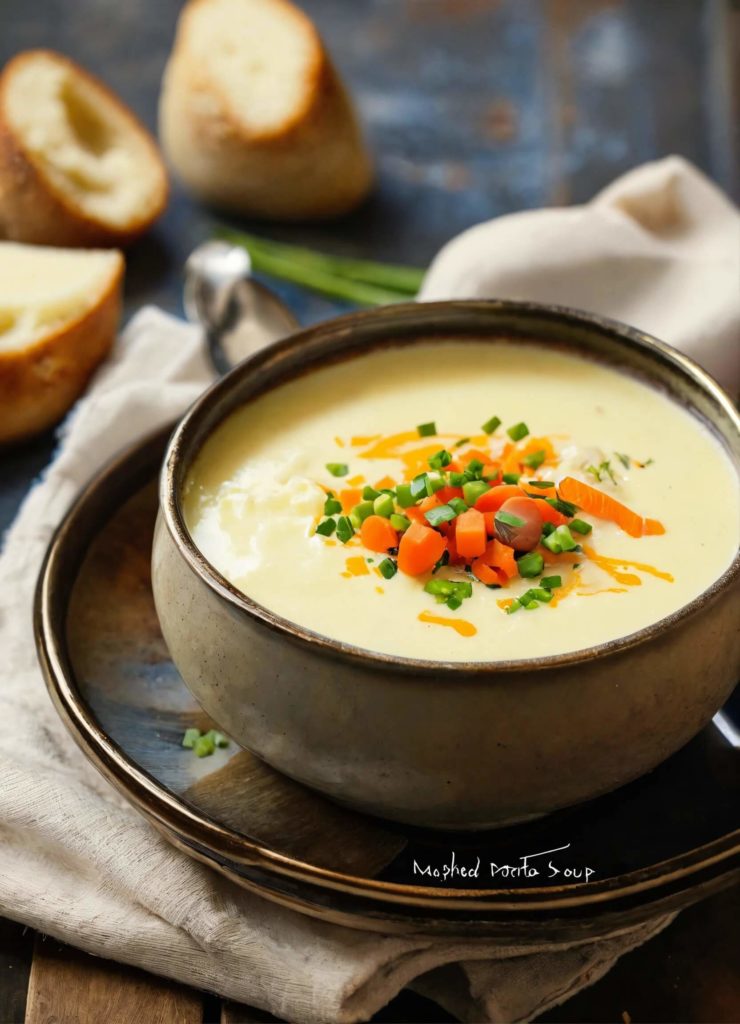Introduction and Basics of Mashed Potato Soup
Introduction to Mashed Potato Soup
Mashed potato soup stands as a quintessential comfort food, beloved for its creamy texture and heartwarming qualities. This soup, often made from simple, readily available ingredients, epitomizes home cooking at its finest. Its popularity spans across various cultures and kitchens, owing to its versatility and the ease with which it can be customized to suit different palates and dietary needs.
The appeal of mashed potato soup lies in its ability to transform a classic side dish into a satisfying main course. The base of the soup typically includes mashed potatoes, which provide a rich and velvety texture. This is then enhanced with ingredients like broth, cream, and seasonings, creating a dish that is both nourishing and indulgent.
Its versatility is further showcased in the myriad of variations it can undergo. From the addition of meats like bacon or ham to the inclusion of vegetables like leeks or carrots, mashed potato soup can be adapted to fit any flavor profile. It’s a canvas for culinary creativity, allowing cooks to add their unique twist, whether it’s a spicy kick, a herbaceous note, or a cheesy depth.
This adaptability also extends to its suitability for various dietary preferences. Vegetarian, vegan, gluten-free, and dairy-free versions are easily achievable, making mashed potato soup a universal favorite. Its ability to cater to a wide audience is a testament to its enduring popularity and status as a staple in the realm of comfort food.
The Origin and Cultural Significance of Mashed Potato Soup
The historical roots of mashed potato soup trace back to the basic human need for nourishing and hearty meals, particularly in colder climates. Potatoes, being a staple crop in many parts of the world, naturally found their way into various soup recipes. The origin of this soup can be linked to the broader history of potatoes, which were first domesticated in South America and later introduced to Europe in the 16th century.
As potatoes became a widespread and affordable food source, they were embraced by various cultures, leading to the creation of numerous potato-based dishes, including mashed potato soup. This soup became especially popular in regions where potatoes were a primary crop, offering a filling and energy-rich meal.
Culturally, mashed potato soup has been adapted in numerous ways, reflecting local tastes and available ingredients. For instance, in some European countries, it’s common to find this soup enriched with local cheeses and meats, while in other regions, spices and herbs unique to their cuisine are added for distinct flavors.
These adaptations highlight the soup’s cultural significance as a comfort food that transcends borders. It’s a dish that has been embraced and personalized by various culinary traditions, making it a beloved and familiar meal in many households around the world. The simplicity and versatility of mashed potato soup have allowed it to endure through time, continually evolving while maintaining its essence as a comforting and satisfying dish. For a deeper understanding of its cultural variations, explore Katie’s Cucina: Mashed Potato Soup, which offers a modern take on this classic dish.
Essential Ingredients for Mashed Potato Soup
At the heart of mashed potato soup are a few key ingredients that form its base: potatoes, broth, and dairy. These components are crucial in creating the soup’s signature creamy texture and rich flavor.
- Potatoes: The foundation of the soup, potatoes are essential for the thick, velvety consistency. Starchy varieties like Russets or Yukon Golds are preferred for their ability to mash well and create a smooth texture.
- Broth: Chicken, vegetable, or beef broth adds depth and richness to the soup. The choice of broth can influence the overall flavor profile, with each type bringing its unique characteristics.
- Dairy: Milk, cream, or a combination of both is used to achieve the creamy consistency that mashed potato soup is known for. Full-fat dairy adds a rich luxury to the soup, whereas 2% milk creates a lighter, less indulgent version.
For flavor enhancement, there are numerous optional add-ins:
- Aromatics: Onions, garlic, and leeks can be sautéed at the beginning to build a flavor base.
- Herbs and Spices: Thyme, rosemary, or bay leaves add a fragrant touch, while spices like paprika or nutmeg can introduce warmth and complexity.
- Cheese: Stirring in grated cheese like cheddar or Parmesan at the end of cooking adds a savory, tangy element.
- Meats: Adding bacon, ham, or sausage creates a robust and meaty version of the soup.
- Vegetables: Incorporate carrots, celery, or spinach for additional nutrition and color in the soup.
These ingredients and add-ins allow for customization, making mashed potato soup a versatile dish that can be tailored to suit various tastes and dietary preferences. For more potato-based recipes, check out KitchenFlavors’ Cheesy Mashed Potatoes.
Preparation, Cooking Tips, and Serving
Step-by-Step Guide to Making Mashed Potato Soup
Creating a delicious mashed potato soup is a straightforward process that involves careful preparation of the potatoes and a few key cooking techniques. Here’s a step-by-step guide to ensure your soup is flavorful and has the perfect consistency:
-
Selecting and Preparing the Potatoes:
- Choose starchy potatoes like Russets or Yukon Golds for their creamy texture.
- Peel the potatoes and cut them into uniform pieces to ensure even cooking.
- Boil the potatoes in salted water until they are tender, which usually takes about 15-20 minutes.
-
Mashing the Potatoes:
- After cooking, drain the potatoes and return them to the pot for mashing.
- Mash the potatoes while they are still hot. For a smoother texture, use a potato ricer or food mill. If you prefer a chunkier soup, a regular potato masher will do.
-
Cooking the Soup:
- In a separate pot, sauté your chosen aromatics (like onions or garlic) in butter or oil until they are soft and fragrant.
- Sprinkle in some flour to create a roux, which will help thicken the soup.
- Gradually add your broth, stirring continuously to avoid lumps. Bring the mixture to a simmer.
- Incorporate the mashed potatoes into the broth. Stir well to combine and break up any large potato chunks.
- Add your dairy component (milk or cream) and any additional seasonings (like herbs, salt, and pepper). Continue to cook on low heat, stirring occasionally, until the soup reaches a creamy consistency.
-
Adjusting the Consistency and Flavor:
- If the soup is too thick, add more broth or milk to reach your desired consistency.
- Taste the soup and adjust the seasoning as needed. This is also the time to add any cheese or cooked meats.
-
Serving the Soup:
- Ladle the soup into bowls and garnish with toppings like chopped chives, grated cheese, or crispy bacon bits.
- Serve hot, accompanied by crusty bread or a side salad for a complete meal.
By following these steps, you can create a comforting and satisfying bowl of mashed potato soup that is perfect for any occasion.
Creative Variations of Mashed Potato Soup
Mashed potato soup’s versatility allows for various adaptations to cater to different tastes. By incorporating various types of potatoes, meats, vegetables, and spices, you can create unique flavors and textures that elevate this classic soup to new culinary heights.
-
Incorporating Different Types of Potatoes:
- Beyond the traditional Russet or Yukon Gold, consider using red potatoes for a slightly waxy texture or sweet potatoes for a hint of sweetness.
- For a more rustic soup, leave the skins on the potatoes for added texture and nutrients.
- Experiment with a mix of different potato types to achieve a complex flavor profile.
-
Adding Meats for a Hearty Version:
- Cooked and crumbled bacon adds a smoky flavor and a satisfying crunch.
- For a heartier soup, include diced ham or sausage.
- For a luxurious twist, consider adding shredded chicken or even lobster.
-
Vegetables for Nutrition and Color:
- Sautéed leeks, carrots, or celery add depth of flavor as well as vibrant color.
- Add spinach, kale, or other greens at the end of cooking to boost the soup’s nutritional value.
- Roasted garlic or caramelized onions can introduce a sweet and complex flavor.
-
Spices and Herbs for Unique Flavors:
- Classic herbs like thyme, rosemary, or bay leaves infuse the soup with a fragrant aroma.
- Spices such as paprika, cumin, or curry powder can give the soup an unexpected and delightful twist.
- For a bit of heat, add a dash of cayenne pepper or some diced jalapeños.
-
International Influences:
- Incorporate flavors from around the world, like adding coconut milk and Thai curry paste for an Asian-inspired version.
- Stir in some pesto or sun-dried tomatoes for an Italian twist.
These creative variations of mashed potato soup allow you to tailor the dish to your personal preferences or to what you have on hand in your kitchen. Each variation brings its unique character to the soup, making it a versatile and exciting dish to prepare and enjoy. For more ideas, check out Allrecipes: Best Potato Soups, which showcases a range of potato soup recipes.
Serving and Presentation Ideas
Presentation and serving style significantly enhance the mashed potato soup’s dining appeal. Thoughtful plating and garnishing, along with strategic pairings with sides and beverages, can turn this simple dish into a gourmet experience.
- Plating and Garnishing Tips:
- Serve the soup in a warm bowl to keep it hot. A shallow bowl showcases the soup’s creamy texture.
- Garnish is key to adding color and texture. Sprinkle with fresh herbs like parsley or chives for a pop of green. Crispy bacon bits, shredded cheese, or a dollop of sour cream can add both flavor and visual appeal.
- For an elegant touch, drizzle a small amount of high-quality olive oil or truffle oil on top just before serving.
- Pairing with Sides:
- Mashed potato soup pairs wonderfully with crusty bread or garlic toast, perfect for dipping and adding a crunchy contrast.
- A light, crisp salad with a tangy vinaigrette can balance the richness of the soup.
- For a heartier meal, consider serving the soup alongside a sandwich or a grilled cheese.
- Beverage Pairings:
- A sparkling water with a twist of lemon or an herbal tea can be refreshing.
By paying attention to these serving and presentation details, you can elevate mashed potato soup from a simple comfort food to an impressive culinary creation, perfect for both casual family dinners and more formal gatherings.
Frequently Asked Questions
Q: Can I make mashed potato soup in advance? A: Yes, you can prepare mashed potato soup ahead of time. The soup can be refrigerated and stored safely for up to three days. Reheat it on the stove over low heat, stirring occasionally. If the soup has thickened in the fridge, you can thin it with a little extra broth or milk.
Q: What are the best potatoes to use for this soup? A: Starchy potatoes like Russets or Yukon Golds are ideal for mashed potato soup. They break down easily and create a creamy texture. Using waxy potatoes like red or fingerling varieties results in a chunkier soup texture.
Q: How can I thicken my mashed potato soup? A: If your soup is too thin, you can thicken it by simmering it for a longer time to reduce the liquid. Alternatively, you can mash a few more boiled potatoes and add them to the soup. Use a flour and butter roux as a thickener for the soup.



